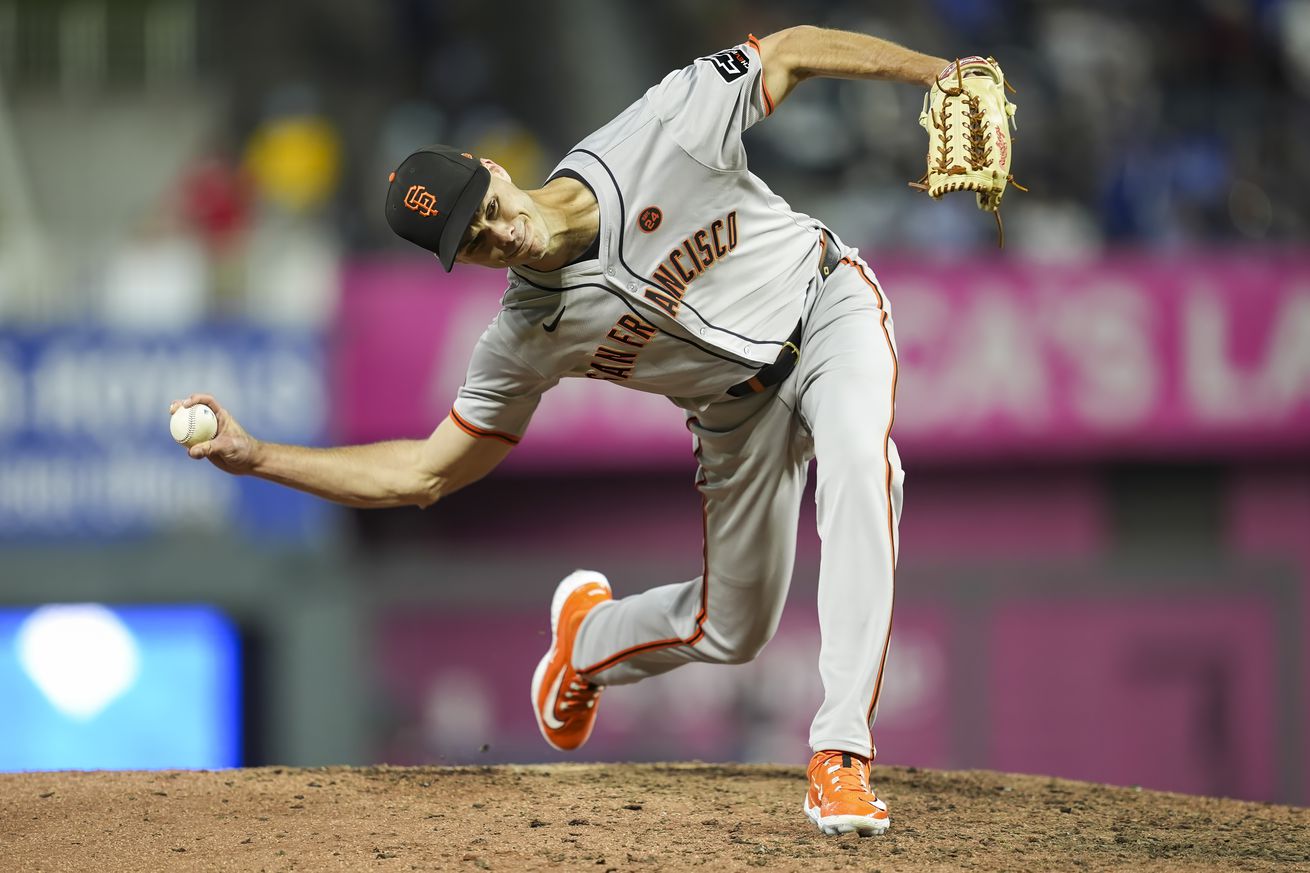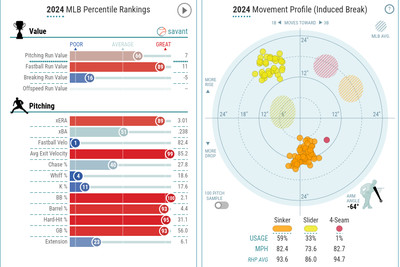
The fool on the hill
2024 stats: 77 G, 70.1 IP, 2.82 ERA (2.90 xERA), 3.56 FIP, 6.53 K/9, 0.77 BB/9, 1.04 WHIP, 0.6 fWAR
It took 300 innings and 288 appearances stretched across six seasons for our own Bryan Murphy to lay down his arms, open his heart and admit that Tyler Rogers was not a gimmick, or mascot, but actually a player who contributed value to a Major League baseball team.
“Bullpens are never reliable, but for five seasons now, that’s what Tyler Rogers has been. Does reliable mean anything? Yes. In baseball it means everything.”
Words of praise certainly mean more from Bryan than they do from me. Personally, I’m a fire hydrant of gush — unabashed in positivity and unashamed in frankly ridiculous comparison. Be it an octopus or a Picasso painting — since I started writing for this site in 2021, I have contorted my posts, much like his submarine delivery, in ridiculous attempts to capture the essence of, the marvel that is, Tyler Rogers.
Reliability is an apt descriptor of what Rogers brings to the San Francisco Giants bullpen, and it is absolutely a trait worthy of celebration. Having honored “The Core Four” earlier this season, having bore witness to the meltdown of Camilo Doval, fans should know this better than anybody. The average lifespan of a reliever in this era of high-velocity and shoulder-strain is comparable to a green lacewing, flitting in and through and out of effectiveness in a matter of months. Rogers then is some kind of crustacean, an ageless lobster bedecked in barnacled carapace shuffling along the seafloor in understated (and underhanded) consistency.
Lobster immortality is a myth, but there’s a reason the myth is believable. These are creatures designed to sustain themselves. Same goes for Rogers. Death — as in fatigue, ineffectiveness — will come … eventually. But given the forgiving and unique nature of the submarine arm angle, Rogers, even as he enters his age-34 and seventh season in the MLB, appears primed to sling baseballs for years to come.
In fact, since his rookie season in 2019, he sits fifth in terms of innings pitched and eighth in appearances for all relievers — easily the most on both counts for a player who’s remained with a single team. He’s thrown 70-plus innings in each of his last four seasons. This year’s 77 appearances were three from his career high of 80 in 2021, and his third time leading National League relievers in games played. Of the top-30 arms in terms of games over the last six seasons, Rogers’s 2.93 ERA is bested only by Raisel Iglesias, Josh Hader, and Emmanuel Clase.
Over the course of 2024, Rogers climbed past the likes of George Kontos, Stu Miller, Frank Linzy, Brian Wilson, and Hoyt Wilhelm on the franchise’s relief appearance leaderboard. His 339 games is good for 11th on that list, and if he can mimic a similar workload in 2025, he would easily pass Robb Nenn and Félix Rodríguez, and fix his name among the vaulted Jeremy Affedlt (414 G), Santiago Casilla (414), and Rodd Beck (416).
A significant aspect of maintaining reliability is presence. Rogers is an odd duck, probably a bit awkward at dinner parties, but at least he’s there, seemingly always available. The only log on his career transactions page is a three-day stint on the paternity list in April of 2022. 54 of his 77 appearances in 2024 came on zero or one day of rest, and he seems to prefer that heightened level of engagement. He logged a 1.58 ERA over those 54 games (50.1 IP) while more than half of the earned runs he allowed (13 of 22) came in games he had two or more days of rest. A fact all the more impressive given the kind of high-pressure situations he consistently faced. He entered a game before the 7th inning only one time last season, making 60 appearances in the 8th inning. 65 appearances came with the Giants courting a lead or the score tied.
Of the 36 times he appeared in a save situation, Rogers maintained the Giants lead 32 times — the second highest Hold total in the National League. He made 14 appearances in a tie game, and in 10 of those appearances, he left the mound with the score unchanged. It’s not the most heralded of jobs. His greatest moments served as steps in the rising action, but were rarely definitive or the most climactic in terms of game narrative. Hold the line was the goal, navigate through his frame unscathed in order to warrant the dramatics of a Doval, or Walker in the 9th.
Relievers as a rule, especially late-inning and high-leverage ones, live their lives out in the open. They can cover themselves up in warm-up jackets and hoods, hidden away in the bullpen for seven or eight innings of a game, but there’s no place to hide when they take the mound, nor much grace for costly mistakes, for leads lost. Considering the weapons Tyler Rogers takes into battle, these elevated stakes ratchet to an even higher level for him. A low-80s sinker, a slicing slider that tops out around 75 MPH — how can he not feel exposed? Naked in the blinding glare of a spotlight? Paralyzed by imposter syndrome? Can we just take a moment to admire Rogers’s mental resolve to not only do this once in a season, but a league leading 77 times.
Day after day, game after game, Rogers goes through this incredible motion: he toes the rubber, props up his rubber band arm hanging from his shoulder, stares down the batter jumping out of his shoes, salivating in the box, then inhales, exhales, and…throws; and not only does he release the baseball, but he directs this lob over the plate! Arguably the most significant difference in the 2024 iteration of Rogers was this “attack” — for lack of a better word — of the strike zone. Rogers peppered the plate to a careless degree all year. Just vulnerable baseballs within a bat’s reach for days. His 59.5 Zone% was a 6-percent jump from his 2023 rate, and 10-percentage points higher than the MLB average. No one in the Major Leagues (min. 200 PA) put pitches over the plate at a higher clip than Tyler Rogers, nor did anybody walk batters at a lower rate. Though he plunked a couple of guys, he didn’t issue his first real walk (i.e. not an intentional one) until his 37th game of the year on June 18th. His 2.1 BB% and 0.8 BB/9 were an outlier even for himself — so much so that his SO/BB jumped from 3.16 in 2023 to 8.50 last season.

In many ways, Rogers, the antithesis of Statcast-era pitching given his lack of velocity or spin or swing-and-miss stuff, is a Statcast darling. His ground-level release point, low fastball velocity and illusory rise on his offerings have consistently limited meaningful contact from opposing hitters at an elite level. And is that not the quote-unquote rub of pitching. Not to completely avoid hitters hitting, but to dictate how hitters hit. Opponent’s 85.2 average exit velocity against Rogers in 2024 was in the league’s 99th percentile, while Barrel % (4.4%), Hard-Hit% (31.1%) and ground ball% (56%) were all rates that flirted with the game’s best marks.
Rogers’s mechanics and offerings statistically offer the highest probability of snuffing out the spark of a hitter, but life inevitably finds a way. Meltdowns Rogers can be susceptible to seem to boil and brew just below the surface of every service he offers. The fact that he keeps offensive eruption at bay for the vast majority of his appearances is impressive, and the inevitability of those occasionally overflowing serve as a humble reminder of the miraculous and improbable works he usually performs. Because for all intents and purposes, what Rogers gives up each outing should be peppered and sprayed between the foul lines of a baseball diamond.
In fact, in his first appearance after Bryan’s article of adoration, Rogers suffered his first real blip of the season, blowing a 3-1 lead against the Mets in the 9th. He’d give up three more runs in an appearance three more times — none more odd than his outing against Seattle in which he surrendered 4 runs (3 earned) on five singles and an error (at the time, the official scorer logged 6 singles) without recording an out. It was the third time in his career that Rogers had not recorded an out after entering a game, and the first time in more than two seasons (June 19th, 2022).
The possibility of this type of strange is part of Tyler Rogers’s thrill. There’s witchy air about the ball as it moves. Reality beguiles the expected. Funk begets funk. Weird creates weird. Rogers is a man completely alien to his time, and yet his success feels completely beholden to it. There is some truth to Bryan’s original criticism that he’s more of a mascot than anything else. He’s a goofy-looking guy doing a goofy thing with a baseball — and it’s funny because it works. The Shakespearean jester, by acting as comedic relief, can say what no one else can say, often revealing the blind spots and flaws of archetypal heroes. Rogers’s willingness to play the fool on the hill often does exactly that on baseball’s stage — and his commitment to the bit is admirable.